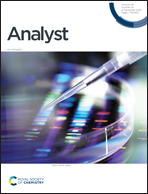Enhanced dimethyl methylphosphonate detection based on two-dimensional WSe2 nanosheets at room temperature†
Abstract
Chemical warfare agents, particularly nerve agents such as sarin, are exceptionally harmful and incredibly perilous to people. Thus, the sensitive detection of these gases is indispensable for reducing the risk of chemical weapons. Herein, we fabricated a room-temperature chemiresistive gas sensor based on two-dimensional few-layer tungsten diselenide (WSe2) nanosheets, which were prepared through a facile liquid-phase exfoliation method. The WSe2-based sensor has demonstrated sensitive and selective detection of dimethyl methylphosphonate (DMMP), which is a well-known simulant of the nerve agent sarin. The sensor based on WSe2 nanosheets revealed a high response reaching 8.91% to 10 ppm DMMP with a fast response time of 100 s. Furthermore, the sensor displayed reliable stability, excellent selectivity, and a low theoretical limit of detection of about 122 ppb. The enhanced sensing performance of WSe2 nanosheets can be ascribed to the increase of the specific surface area, which provides more active adsorption sites for DMMP molecules, thereby facilitating the charge transfer process between DMMP molecules and WSe2 nanosheets. Overall, our results indicate that two-dimensional transition metal dichalcogenide materials have the potential for the design and fabrication of high-performance nerve agent sensing devices.



 Please wait while we load your content...
Please wait while we load your content...